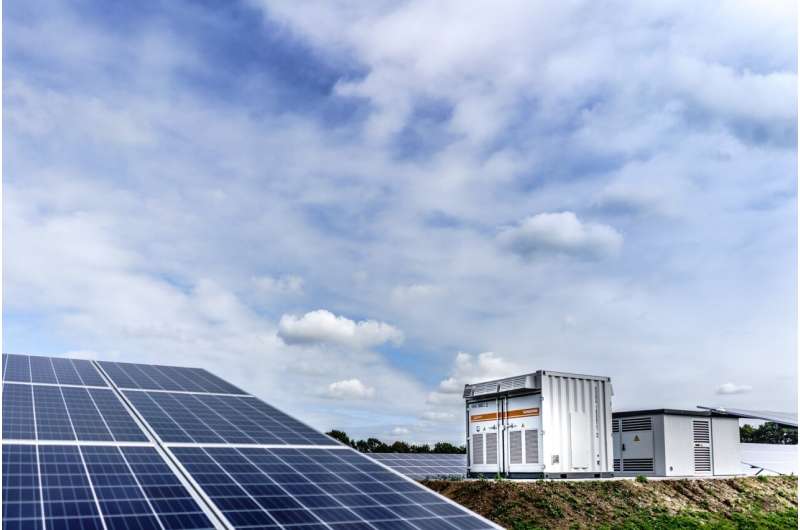This article has been reviewed according to Science X's editorial process and policies. Editors have highlighted the following attributes while ensuring the content's credibility:
fact-checked
trusted source
written by researcher(s)
proofread
Giant batteries to store wind and solar power could speed up South Africa's energy transition

South Africa is at a pivotal moment in its energy transition: trying to decarbonize its economy (move away from coal) and make sure that everyone has access to reliable and affordable energy. Storage of renewable energy is very important for this transition. Solar and wind power are not available all the time. To keep the national grid stable, renewable energy must be stored somewhere and supplied reliably.
The country has already made strides in integrating renewable energy into its power grid through the Renewable Energy Independent Power Producer Procurement Program. Since 2010, this has attracted 110 private independent power projects that have invested R277.2 billion (US$14.6 billion) in renewable energy.
But South Africa's path to a sustainable energy future is complicated by problems with energy storage technologies.
As an electrical engineer and researcher, I focus on energy transitions and the various barriers to the renewable energy rollout across sub-Saharan Africa. My recent research investigates the role of energy storage in South Africa's energy transition.
I reviewed all the existing literature on energy storage technologies, policies and market trends in South Africa to determine the overall state of renewable energy storage. I also wanted to find out how renewable energy storage can bring more renewable energy into the national grid, and make the grid more reliable.
Different types of energy storage exist. For example, lithium-ion batteries can store energy in various amounts, from small (phone-sized) to large (town-sized), depending on their size and purpose.
Pumped storage hydropower is another way of storing energy. This is done by pumping water from a lower dam to an upper dam during off-peak hours, and then releasing it to generate electricity when needed. This is similar to a rechargeable battery but uses water and gravity.
Thermal energy storage devices which heat or cool substances so the energy can be used later are other options. There are ongoing discussions on the potential of green hydrogen for energy storage.
My research found that in the past, pumped storage schemes were a significant part of South Africa's plans for expanding its electricity generation capacity. However, interest in this form of renewable energy storage has declined. This is mainly because of concerns in the industry that there may not be enough water to make these possible in future.
Today, large renewable energy battery systems are seen as the best future option for storing renewable power with South Africa's state-owned electricity company, Eskom, beginning to set up battery storage.
Stuck with carbon
Several factors complicate South Africa's transition to a low-carbon energy system.
First, there is a historical dependency on coal due to its abundance and the economic importance of the mining industry. This dependency creates resistance to change, both politically and economically.
Second, there is a lack of investment in expanding the national grid. It needs to be upgraded so that renewable energy can be fed into it. Eskom has a massive debt burden. With much of its revenue directed toward servicing debt, Eskom has limited funds available for infrastructure improvements.
Short-term or inconsistent policy commitments by the government are another problem. These can create uncertainty about the future of clean energy investments, making it difficult for businesses to plan long-term.
However, planning must happen. Renewable energy sources, such as wind and solar, are intermittent and their output fluctuates based on weather conditions and the time of day. To address this, countries like the UK, Germany and the US have set up grid-scale storage: large systems that store electricity for later use. This helps balance the supply and demand on the power grid.
Grid-scale storage includes batteries and other technologies such as compressed air energy storage. South Africa, facing similar challenges with renewable energy intermittency, could benefit from adopting these proven energy storage technologies.
Incentives, skills, regulation
Energy storage technologies, particularly batteries, lower greenhouse gas emissions. In fact, they can drive decarbonization.
But high costs are a problem. The government and private sector must collaborate to create financial incentives and support research and development in energy storage solutions.
It is also essential to build a skilled workforce of local expertise in energy storage technologies.
Battery storage may be technically able to provide an essential service to the grid. But if no regulations or guidelines explicitly state that storage can provide these services, utilities and market operators may be unwilling to invest in renewable energy storage systems. Regulations are needed to explicitly recognize that renewable energy storage batteries are a key part of energy markets and provide essential services to the grid.
Clear guidelines on technical requirements, market participation and compensation mechanisms will enable battery storage to contribute to a more resilient, efficient and sustainable energy system.
Policies, partnerships, public and planning
First, the government should implement clear and supportive policies that create incentives for investment in energy storage technologies. Tax breaks, subsidies and grants for research and development are globally practiced policies that work well.
Second, fostering partnerships between universities, research institutions and the private sector can drive innovation and reduce costs. Collaborative efforts can find solutions tailored to South Africa's unique energy needs.
Third, public awareness and understanding of the benefits of energy storage is crucial. Educational campaigns and community engagement initiatives can build public support for clean energy technologies. This will make it easier for clean energy to get wide support.
Finally, integrating energy storage into national energy planning is essential. This means making sure that storage solutions are a key part of how the country produces and uses energy, especially in big future projects.
This article is republished from The Conversation under a Creative Commons license. Read the original article.![]()


















